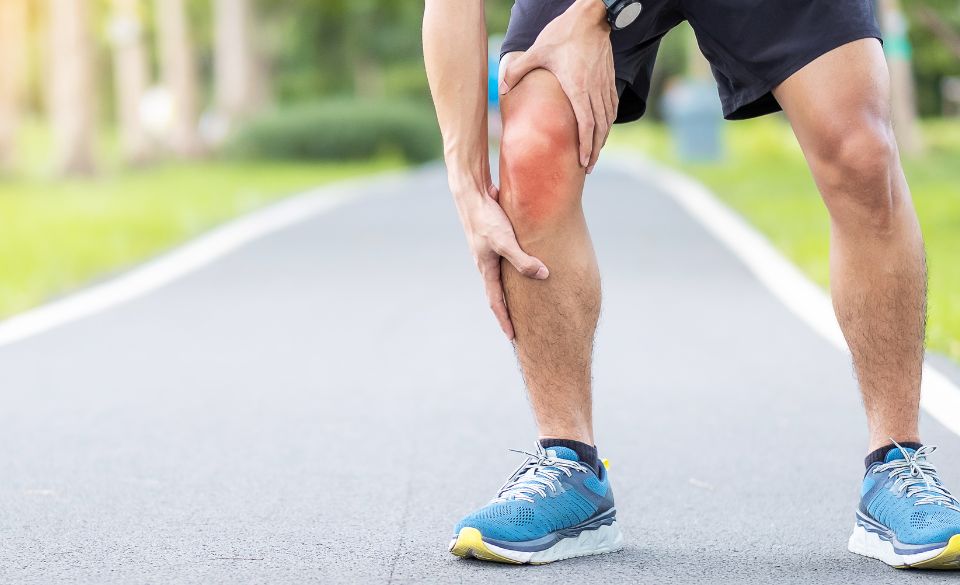
Understanding Patellar Tendonitis: Causes, Symptoms, and Runner-Focused Treatment Options
Page Contents
- What is Patellar Tendonitis?
- The Causes of Patellar Tendinitis in Runners
- Patellar Tendinitis Vs. Runner’s Knee
- How to Treat Patellar Tendinitis in Runners
- How to Prevent Patellar Tendinitis While Running
- How to Strengthen Muscles to Prevent Patellar Tendonitis
- Patellar Tendonitis in Runners – The Conclusion
Hey there, fellow runners! Today, let’s dive into an all-too-common yet often misunderstood injury that can put a damper on our running goals – Patellar Tendonitis! Also known as “jumper’s knee,” this condition can be a real pain in the… well, knee. But don’t worry; we’ve got you covered with valuable insights, tips, and exercises to help you deal with patellar tendonitis like a pro.
What is Patellar Tendonitis?
Patellar Tendonitis, also known as “jumper’s knee,” is a pesky condition that affects the patellar tendon, which connects the kneecap (patella) to the shinbone (tibia). When this tendon becomes irritated and inflamed, it leads to the development of patellar tendonitis. This condition commonly occurs in athletes who participate in activities that involve repetitive jumping or running, hence the nickname “jumper’s knee.”
The patellar tendon plays a crucial role in helping the quadriceps muscles extend the leg, allowing us to jump, run, and perform various lower body movements. However, overuse or excessive stress on the patellar tendon can cause tiny tears and inflammation, leading to the onset of patellar tendonitis. It’s like a signal from our knees, telling us, “Hey, slow down a bit and give me a break!”
Runners, in particular, are prone to developing patellar tendonitis due to the repetitive impact and stress on the knees while running. Factors such as overtraining, sudden increases in running intensity, running on hard surfaces, and even improper running mechanics can contribute to the development of this condition. So, it’s essential to understand the causes, symptoms, and treatment options to effectively manage patellar tendonitis and keep those knees happy and healthy.
The Causes of Patellar Tendinitis in Runners
When it comes to the causes of patellar tendinitis in runners, there are several factors at play. Let’s explore them:
1. Overuse and Training Errors: One of the primary causes of patellar tendinitis in runners is overuse or repetitive stress on the patellar tendon. When we push ourselves too hard or increase our running distance or intensity too quickly, our tendons may not have enough time to adapt and recover. This can lead to the development of tendonitis. It’s important to gradually increase your training volume and listen to your body’s signals to avoid overloading the tendon.
2. Biomechanical Issues: Poor running mechanics or biomechanical imbalances can contribute to the development of patellar tendinitis. Factors such as improper foot strike, excessive pronation (inward rolling of the foot), or weakness in the hip and core muscles can place additional strain on the patellar tendon. Working on improving your running form and addressing any muscle imbalances through targeted exercises can help reduce the risk of developing tendonitis.
3. Training Surface: The surface you run on can also impact your risk of developing patellar tendinitis. Running on hard surfaces like concrete or asphalt can increase the stress on your knees and the patellar tendon. Whenever possible, try to incorporate softer surfaces like grass, trails, or rubberized tracks into your training routine. This can help reduce the impact on your tendons and lower the risk of developing tendonitis.
4. Improper Equipment: Wearing worn-out or inappropriate running shoes can contribute to patellar tendinitis. It’s crucial to invest in good-quality running shoes that provide proper cushioning and support for your feet. Ill-fitting shoes or ones that don’t offer adequate stability can alter your gait and increase the strain on your knees and tendons.
5. Muscle Imbalances and Weakness: Imbalances or weaknesses in the muscles surrounding the knee, such as the quadriceps, hamstrings, and glutes, can lead to increased stress on the patellar tendon. Strengthening these muscles through targeted exercises can help distribute the load more evenly and reduce the strain on the tendon.
By understanding these causes and taking proactive steps to address them, runners can significantly reduce their risk of developing patellar tendinitis. It’s essential to listen to your body, train smartly, and incorporate proper rest and recovery into your routine to keep your tendons happy and injury-free.
Patellar Tendinitis Vs. Runner’s Knee
Let’s clear up a common confusion: patellar tendinitis versus runner’s knee. While both conditions can cause knee pain, they are different in terms of the specific structures involved and the underlying causes.
Patellar Tendinitis, also known as “jumper’s knee,” specifically targets the patellar tendon. This tendon connects the kneecap (patella) to the shinbone (tibia) and is responsible for transmitting the forces produced by the quadriceps muscles during movements like jumping and running. Patellar tendinitis occurs when the patellar tendon becomes irritated, inflamed, and develops small tears due to overuse or repetitive stress. Runners often experience this condition because of the high-impact nature of running and the strain it places on the patellar tendon.
Runner’s Knee, on the other hand, refers to a condition known as patellofemoral pain syndrome. It involves pain around the kneecap (patella) and the surrounding tissues. Runner’s knee is more of a general term that encompasses various issues related to the patellofemoral joint, such as misalignment, muscle imbalances, or cartilage problems. Unlike patellar tendinitis, runner’s knee is not solely focused on the patellar tendon but rather involves a broader range of factors affecting the kneecap and its interaction with the femur.
While there may be some overlap in symptoms and risk factors, it’s important to differentiate between patellar tendinitis and runner’s knee for accurate diagnosis and appropriate treatment. If you’re experiencing knee pain, it’s advisable to consult a medical professional who can evaluate your specific condition and provide a proper diagnosis.
How to Treat Patellar Tendinitis in Runners
If you’re dealing with patellar tendinitis as a runner, the good news is that there are several effective treatment options to help you recover and get back on track. Here are some strategies to consider:
1. Rest and Modify Activity: First and foremost, give your knees a break. Resting and avoiding activities that exacerbate the pain, such as running or jumping, can allow the inflamed patellar tendon to heal. You may need to temporarily modify your training routine by incorporating low-impact exercises like swimming or cycling until the pain subsides.
2. Ice and Anti-inflammatory Medication: Applying ice to the affected area for 15-20 minutes several times a day can help reduce pain and inflammation. Nonsteroidal anti-inflammatory drugs (NSAIDs), such as ibuprofen, can also be used to alleviate pain and swelling. However, consult with a healthcare professional before taking any medication.
3. Physical Therapy: Working with a physical therapist who specializes in sports-related injuries can be highly beneficial for treating patellar tendinitis. They can assess your condition, develop a personalized treatment plan, and guide you through exercises to strengthen the surrounding muscles, improve flexibility, and correct any biomechanical issues contributing to the condition. Physical therapy may include techniques such as eccentric exercises, stretching, ultrasound therapy, or soft tissue mobilization.
4. Bracing or Taping: In some cases, wearing a knee brace or using supportive taping techniques can provide temporary relief by reducing stress on the patellar tendon. These external supports can help stabilize the knee joint and provide compression, which may alleviate pain during activity. However, it’s important to consult with a healthcare professional to determine the most appropriate bracing or taping technique for your specific situation.
5. Gradual Return to Activity: Once the pain subsides and you’ve made progress in strengthening the surrounding muscles, a gradual return to running can be considered. Start with low-impact exercises and gradually increase the intensity and duration of your runs. Listen to your body and be mindful of any discomfort or pain. If necessary, consult with a physical therapist or sports medicine specialist to guide you through a safe and progressive return to running.
Remember, the key to treating patellar tendinitis is patience and consistency. Recovery may take time, so it’s important not to rush the process and risk re-injury. Be proactive in following your treatment plan, focus on strengthening the supporting muscles, and seek professional guidance when needed.
How to Prevent Patellar Tendinitis While Running
Prevention is always better than cure, and when it comes to patellar tendinitis, there are steps you can take to reduce the risk of developing it while running. Here are some tips to help prevent patellar tendinitis:
1. Gradual Training Progression: One of the key factors in preventing patellar tendinitis is allowing your body to adapt gradually to the demands of running. Avoid sudden increases in mileage, intensity, or frequency of your runs. Instead, follow a structured training plan that incorporates progressive increments to give your tendons and muscles time to strengthen and adjust.
2. Proper Warm-Up and Cool-Down: Before each run, dedicate time to warm up properly. Dynamic stretches, light jogging, or exercises that target the lower body can help increase blood flow, warm up the muscles, and prepare them for the upcoming activity. Similarly, after your run, cool down with gentle stretches to promote muscle recovery and flexibility.
3. Listen to Your Body: Pay attention to any early signs of discomfort or pain in your knees or around the patellar tendon. If you experience persistent pain or swelling, it’s crucial to listen to your body and take appropriate rest days. Ignoring the signals and pushing through the pain can lead to overuse injuries, including patellar tendinitis.
4. Choose Appropriate Footwear: Investing in good-quality running shoes that are appropriate for your foot type and running style is essential. Shoes with proper cushioning, support, and shock absorption can help reduce the impact on your knees and minimize the strain on the patellar tendon. Consider consulting with a professional at a specialty running store to find the right shoes for you.
5. Strengthen Supporting Muscles: Strong muscles surrounding the knees, such as the quadriceps, hamstrings, and glutes, can help alleviate stress on the patellar tendon. Incorporate strength training exercises into your routine that target these muscle groups. Squats, lunges, step-ups, and bridges are examples of exercises that can help improve strength and stability in the lower body.
6. Cross-Training and Varying Surfaces: Incorporating cross-training activities, such as swimming, cycling, or strength training, can reduce the repetitive impact on your knees and provide a well-rounded approach to fitness. Additionally, consider varying your running surfaces. Mixing in softer surfaces like grass, trails, or rubberized tracks can help decrease the strain on your tendons and reduce the risk of overuse injuries.
7. Proper Running Technique: Pay attention to your running form and mechanics. Strive for an efficient stride, avoiding excessive heel striking or overstriding, which can increase the stress on your knees and tendons. If you’re unsure about your running technique, consider consulting with a running coach or physical therapist who can provide guidance and help you make any necessary adjustments.
Remember, prevention is a continuous effort. By incorporating these strategies into your running routine and being mindful of your body’s needs, you can significantly reduce the risk of developing patellar tendinitis and enjoy a more injury-free running experience.
How to Strengthen Muscles to Prevent Patellar Tendonitis
Strengthening the muscles around the knees is crucial for preventing patellar tendinitis. By improving the strength and stability of these muscles, you can better support the patellar tendon and reduce the risk of overuse injuries. Here are some exercises that target the key muscle groups involved:
Quadriceps Strengthening:
Wall Sit: Stand with your back against a wall and slide down until your knees are bent at a 90-degree angle. Hold this position for 30-60 seconds, gradually increasing the duration as you get stronger.
Lunges: Take a step forward with one leg and lower your body until both knees are bent at a 90-degree angle. Push back up to the starting position and repeat with the other leg. Aim for 2-3 sets of 10-12 repetitions per leg.
Hamstring Strengthening:
Hamstring Curls: Lie face down on a mat, bend your knees, and bring your heels toward your glutes. Slowly lower your legs back down. Aim for 2-3 sets of 10-15 repetitions.
Deadlifts: Holding a dumbbell or barbell with an overhand grip, hinge at your hips and lower the weight while keeping your back straight. Push through your heels to stand back up. Start with light weights and gradually increase as your strength improves.
Glute Strengthening:
Bridges: Lie on your back with your knees bent and feet flat on the ground. Lift your hips off the ground, squeezing your glutes at the top. Lower back down and repeat for 2-3 sets of 12-15 repetitions.
Clamshells: Lie on your side with your knees bent and hips stacked. Keeping your feet together, open and close your top knee like a clamshell. Aim for 2-3 sets of 15-20 repetitions per side.
Calf Strengthening:
Calf Raises: Stand with your feet hip-width apart and rise up onto your toes. Slowly lower back down. For an added challenge, perform calf raises on a step or ledge, allowing your heels to drop below the step. Aim for 2-3 sets of 12-15 repetitions.
Remember to start with lighter weights or easier variations of the exercises and gradually increase the intensity as your strength improves. It’s also essential to maintain proper form throughout each exercise to maximize effectiveness and minimize the risk of injury. If you’re unsure about the correct technique, consider working with a qualified fitness professional or physical therapist who can guide you through the exercises and tailor a program to your specific needs.
Incorporating these exercises into your regular training routine can help strengthen the muscles surrounding the knees, promote better stability, and reduce the risk of patellar tendinitis. However, it’s important to listen to your body and avoid overtraining. If you experience any pain or discomfort during exercise, modify or stop the exercise and consult with a healthcare professional.
Patellar Tendonitis in Runners – The Conclusion
In conclusion, patellar tendonitis can be a frustrating setback for runners, but it’s not the end of the road. By understanding the causes, symptoms, and treatment options, we can take proactive steps to manage and prevent this condition. Remember to listen to your body, give yourself ample rest, and incorporate strengthening exercises into your routine. With patience, care, and the right approach, you’ll be back on the road, leaving patellar tendonitis in the dust.



